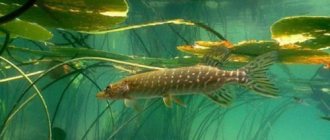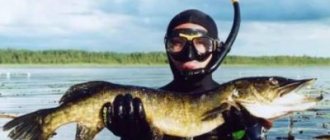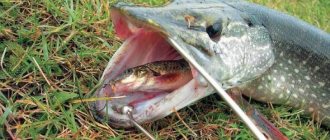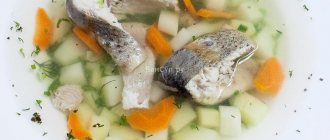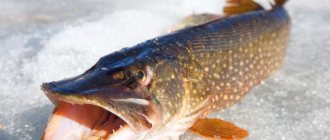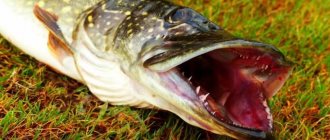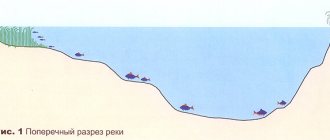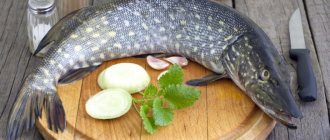What is a fishing yawn?
A snapper is a tool used to safely remove a hook from the mouth of predatory fish. Its use allows you to avoid cuts on your hands and simplifies the handling of trophies caught from the water.
In appearance, a fish gapper is a large pin. To make such devices, spring wire (less commonly plastic) is used, with which the mouth of a predatory fish is fixed in an open state. Steel wire has a diameter of 3-5 mm.
Photo: fishing yawn
Experienced fishermen know that such an accessory minimizes the likelihood of damaging your fingers on the hook and fish teeth.
Learning how to make a yawn for pike
Every fisherman knows that very often predatory fish swallow the bait along with the hook very deeply. It will be possible to remove them with your bare hands, but injuries cannot be avoided; it is in such cases that the yawner will come to the rescue; this thing is simply irreplaceable for catching pike.
But not all fishermen can afford to purchase this device. And the point is not at all in its cost, but in the fact that there is no time to go to the store before fishing. Therefore, an option appears in their head on how to make a pike yawn with their own hands, which we will talk about in this article.
What is it and how to use it
A yawn is a device made of spring wire that can be used to secure a pike's mouth in an open position. It is usually made from steel wire with a diameter of 3-5 mm.
The yawn must be squeezed in your hand and inserted into the pike’s mouth, and then released. After this, the fish’s jaws are fixed in an open state, and you can easily remove the bait by hand, using an extractor or pliers.
Zevniks are inexpensive and do not take up much space. You can always have one of these devices with you both during boat fishing and when fishing from the shore. Many novice fishermen neglect this accessory and thus significantly complicate their lives. Sometimes the bait can actually be easily removed from the pike's mouth by hand or with pliers, especially in cases where the hook digs into the edge of the jaw.
Where can I buy a yawner, price
You can buy a yawner at a store that specializes in selling fishing accessories. The order can be made, including via the Internet. As an option, buy a yawner for pike on Aliexpress. Yawners are inexpensive, the price ranges from 50-100 rubles. You can also try making them yourself.
When buying a yawner, you should focus on its quality; it should be durable and easy to use. Metal accessories have the longest service life. Plastic yawners also have advantages: they are lightweight and corrosion-resistant.
Selecting material for self-production
Many craftsmen make yawners at home in the required quantities and the required size. It’s not difficult to do it yourself, but you still need to have certain skills.
In addition to the ability to bend metal, it is important to choose the right material from which the product will be made. For a yawner, they usually take a spoke from a bicycle or steel wire of the required diameter. The main thing is that the selected material does not break or bend during use.
Additionally, for convenience, you can put a rubber or silicone tube on the place where your hands will be located when using the tool. In winter, this addition will prevent the skin of your hands from touching cold metal.
DIY making
Many experienced fishermen prefer to make their own tools that meet their specific needs. Making a pike yawn with your own hands is quite simple. The most important thing is the choice of wire - it should not be too stiff, but at the same time have high elasticity, without bending from weak compression. To make relatively small yawns, ordinary bicycle spokes are often used. In addition to the material, you must have:
- Insulation from a wire corresponding to the diameter of the wire or suitable heat shrink tubing.
- An ordinary steel wire with a diameter of about 1.5 millimeters.
- A round rod or a fairly thick bolt, about 2-3 centimeters in diameter (you can use the handle of a screwdriver).
- Vise.
- Pliers.
- A lighter.
The manufacturing process itself is quite simple and accessible even to a teenager. Necessary:
- Clamp the end of the rod in a vice so that it is convenient to work with the remaining part.
- Place the middle of the wire on the rod and wrap it around it (the number of turns can be from one and a half to three and a half, depending on the hardness of the material). The last turn must be done so that the angle between the ends of the wire is about 40 degrees.
- Trim one of the ends of the future tool so that they become equal in length.
- Stepping back about 2 centimeters from the edge, bend the ends of the wire in different directions at an angle of 90 degrees so that they are strictly parallel to each other.
- Place 2-3 centimeters of heat-shrinkable tubing or plastic insulation from the wire onto the edges of the yawn.
- Using a lighter, heat the tubes so that they are tightly fixed to the wire. It is especially important to melt the ends so that the resulting tool does not injure the fish or scratch the tackle in the box.
- Cut a piece about 4 centimeters long from a thin wire.
- Form two hooks at the ends with a diameter approximately equal to the diameter of the knitting needle from which the shed is made.
- Throw one of the hooks over any of the arms of the resulting instrument and bend it into a full loop, thus obtaining a jumper for fixing the arms in the closed state.
Some anglers make two bends at the ends of the arms to position them opposite each other - first, at a distance of about 3.5 centimeters from the edge, an angle of about 120 degrees is formed, and at a distance of 1.5 centimeters from it another, about 45 degrees, directed towards the opposite side
At this point, the production of a homemade yawner can be considered complete. The main advantage of such gear is that it can be made in a convenient size and shape for the fisherman, suitable specifically for the size of the trophy he is targeting.
From a knitting needle
You will need one knitting needle made of alloy steel (you can take a bicycle one, but the quality will be worse). Visually divide the knitting needle in half, retreat 1.5-2 cm from the middle. Using pliers, bend the knitting needle around a metal rod or file handle with a diameter of 1.5-2 cm, make a full turn, bring the ends of the knitting needle so that an angle of 120° is obtained, compare ends. We retreat 4 cm from the edge and bend it at 45° in a plane perpendicular to the plane of the resulting spring. From the resulting bend in the same plane, bend the knitting needle in the opposite direction, retreating 1.5 cm, so that the total angle between the plane of the yoke and the transverse bar is 90°. We put on a heat-shrinkable tube (preferably a bright color) up to the spring coil and heat it with a hairdryer or gas burner. We do the same with the second arm of the device.
The corners of the cross bars should point in opposite directions. We make a clamp-bracket in the shape of the letter S from rigid wire for convenient transportation of the yawner. We bend one end of the staple around the arm of the device. If you bend the arms of the device in a vertical plane towards each other, then the clamping bracket is not required. The yawn will be fixed in the fastened position due to elasticity and transverse bars. In order not to lose a useful accessory, you can attach it to a flexible suspension.
From a spring
The main difficulty in making a gapper from a spring is that it is necessary to straighten the spring. To do this, use pliers to unbend the coils of the spring and beat them on the anvil. The goal is to get an equal straight workpiece. During manufacturing there should be no chips or cracks on the surface of the spring, otherwise it will burst during the process of repeated bending. We repeat all manipulations, as in the case of the knitting needle. There is a nuance: it is better to make not one, but two or three turns. It is better to re-wind a 2.5 mm thick spring onto a blank with a diameter of 1-1.5 cm.
How to make a pike yawn with your own hands
To make your own yawner, a bicycle spoke or steel wire of the appropriate diameter (usually from 3 to 5 mm) is suitable.
You need to proceed as follows:
- Use pliers to form one and a half turns in the center, using the handle of a file or screwdriver to form the shape.
- Bend the ends of the product so that you get a right angle (they should look in opposite directions), process them with a file, remove burrs.
- Place rubber tubes on the ends of the wire so that the yawner does not cause harm to the fish and things in the angler’s backpack.
About
Is it worth making it yourself?
Self-manufacturing of a gapper should be carried out by someone who has similar skills in working with metal. If you are new to this, then it is better to buy the product in a store.
Their cost is not high, and the hassle is much less. But it is worth remembering that a plastic yawn will have less weight, but in the cold this material is very fragile . And you can’t use it for a large pike; a toothy one can break it. Most often, purchased options are made of metal; you can modify it yourself at home if desired.
You can make a pike yawn with your own hands without any problems, the main thing is that you have the necessary materials and very little time. Every spinning fisherman should have such a product in his arsenal, and preferably more than one, but whether it will be purchased or homemade is up to everyone to decide for themselves.
Device
In the first case, short transverse bridges are welded to the ends of the arms, making it possible to securely fix the fish’s mouth open without holding the instrument with your hand. This arrangement is one of the most convenient, but it, in turn, has one serious drawback. Due to the large number of low-quality tools in stores, many gappers of this design simply break at the welding site, leaving the end pointed, which injures the fish and prevents normal retention of the jaws.
Such low-quality yawners can be found not only in small provincial stalls or markets, but also in large chain stores in Moscow or St. Petersburg, and in general their share is quite high. For this reason, many fishermen use tools of this type only when catching relatively small fish, so as not to be left without it at the most necessary moment.
The second type of gapper has welded metal balls at the ends that protect the fish’s mouth from damage. They are quite reliable and humane, however, in some situations, tools with such shaped ends lack stability, and they can slip and fly out of the mouth if the fish suddenly jerks. Since such situations are fraught with bites when removing deeply embedded bait, it is better to hold this type of yawn with your hand, not allowing it to turn around in the predator’s mouth.
The third type combines the advantages of both types - it has curved tips, at the end of which there are special rubber tips to protect the fish's mouth. They are held quite reliably in the jaws due to the bending of the wire at an angle of 90 degrees, and at the same time this design is very durable due to the absence of any connections, because it is a monolithic piece of metal. However, many fishermen note that such yawns also have disadvantages - rubber tips are often lost on them, which is why spinning anglers prefer to modify them themselves using glue or high temperature.
Treatment of wounds from pike teeth
Although fishermen are simple people and pay little attention to such trifles as wounds from perch thorns and even pike teeth, often these wounds can be quite extensive. And if you remember that pikes don’t clean their teeth and there are a lot of different bacteria on their teeth, then untreated wounds can cause ulcers to develop, which heal differently for everyone. It happens that they turn into prolonged suppuration and inflammation, especially if the hand is wet and not treated with anything. It is advisable to have iodine, brilliant green, and hydrogen peroxide, which is simply called hydrogen peroxide, in your first aid kit. All these antiseptics disinfect wounds, and hydrogen peroxide can stop suppuration. Treated wounds should be covered with adhesive tape.
How to get the spoon out from under the gill cover
In addition to the common and traditional method of removing a spoon from a pike's mouth, there is another method. Here the principle of penetration into the pike’s mouth under its gill cover is used. This method can be adopted in cases where there is not a single necessary tool at hand, as mentioned above, that is, in conditions close to primitive ones. It also happens. To do this, the pike is taken by the so-called scruff, that is, behind the head. Of course, you have to hold it tightly. Pike is a strong fish and, in addition, is covered with protective mucus. The thumb of the hand holding the fish pushes back the gill cover. From this back side, you can usually clearly see the tee of the spoon and how it gets caught in the pike’s mouth, especially if it swallowed the bait quite deeply. Upon initial inspection, it becomes clear which side the spinner is on. If it is not on the side of the hand holding the pike, then you need to intercept the fish with the other hand and repeat the operation performed when the thumb opens the gill cover. With the other hand, you need to carefully unhook the stings of the tees, without touching the gill plates, which can also easily cause injury. After this, when the spoon is unhooked, you need to open the pike’s mouth. Although this is not very easy to do without a yawner, it is nevertheless possible with the help of improvised objects in the form of sticks. Then the fish, shaking, is lowered upside down. The spoon should fall out with a slight pull on the leash or under its own weight. There should be no sharp jerks or strong tension on the fishing line and leash, otherwise everything will repeat from the beginning, when the tee again digs into the pike’s mouth.
It cannot be said that this method of removing a spoon from a pike’s mouth is better than the traditional one, but in some cases it is quite applicable, especially if you remember how wide the gill covers open and how much free space there is under the gill covers for viewing and removing the spoon, compared to the mouth pike.
Fishing yawns
6 minutes Author: Semyon Citizens 0
When catching predatory fish, it becomes extremely important to have a special tool for removing hooks and baits from their fanged mouths in such a way as not to injure your fingers on sharp teeth. For these purposes, there is a fishing jaw, designed to fix the fish's jaws in the open state. Fishing stores now offer a wide selection of snappers, but for most experienced fishermen it will not be difficult to make this tool yourself.
Device
In the first case, short transverse bridges are welded to the ends of the arms, making it possible to securely fix the fish’s mouth open without holding the instrument with your hand. This arrangement is one of the most convenient, but it, in turn, has one serious drawback. Due to the large number of low-quality tools in stores, many gappers of this design simply break at the welding site, leaving the end pointed, which injures the fish and prevents normal retention of the jaws.
Such low-quality yawners can be found not only in small provincial stalls or markets, but also in large chain stores in Moscow or St. Petersburg, and in general their share is quite high. For this reason, many fishermen use tools of this type only when catching relatively small fish, so as not to be left without it at the most necessary moment.
